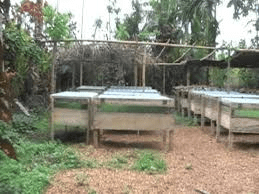The type of snail pen for your snailery depends on a number of factors which include:
1. The scale of the snail farming enterprise;
2. The type of snails farming i.e. In-door or Out-door;
3. The stage of development and habits of the snails.
Size of Snail Pen / Snail House
A snail pen can be large or small depending on how many snails the farmer wants to raise. For a new snail farmer (snail farming for beginners), it is advisable to start with a small pen.
He would need fewer materials and fewer snails for this. As he becomes more experienced in snail farming, he can build a bigger pen and get more snails to raise. A 5m x 5m out-door pen is a suitable size to start with.
Different Types of Snail Pens
1. Hutch Box Method
The hutch boxes which could be single. The floors of the boxes are filled with sieved organic soil to a depth of 5 – 8 cm, which must be slightly limed (Caco). The bottom of the hutch 3boxes have holes to allow excess water to drain out.
The hutch boxes are put under trees like rubber, cocoa, citrus and even plantain for shade. When hutch boxes are used, the soil is changed once every two to three months.
2. Trench Pens

In the trench type, pens, square or rectangular holes (depending on the desired shape of pen) are dug in the ground about 50cm deep. The dug-up area is divided into pens and the sides are built up to 2 – 3 blocks high from the ground level while the bottom is covered with loose soil.
The pens are covered with nylon mesh nailed to wooden frames for lids. The trench pens which more or less look like the hutch pens could be used for hatching.
3. Mini-Paddock Pens
Mini-paddock snailery house or snail pens are small square or rectangular pens, usually within a larger fenced area. They are built of bamboo and nylon mesh, or of timber, chicken wire and nylon mesh.
The walls should be some 50 cm high and be dug at least 20 cm into the ground. Wooden frames are attached to the top of the walls (extended inwards) and covered with the mesh, to prevent snails from escaping.
Plants providing shelter and/or food are planted in the pens before snails are released into them. Suitable plants include cocoyam, sweet potato, fluted pumpkin, and leafy vegetables.
Rectangular pens allow the farmer easier access to the whole area without having to enter the pens. Mini-paddock pens may also be constructed higher above ground, with a completely enclosed frame, and may even be roofed.
4. Free-Range Pens
Essentially, free-range pens are large mini-paddock pens: a fenced area of up to 10 × 20 m, planted with plants, shrubs and trees that provide food and shelter from wind, sun and rain.
Just like in a mini-paddock pen, the vertical fence must be extended inwards, to prevent snails from escaping. If the fence is constructed of fine chicken wire mesh, the overhang is not obligatory because snails dislike crawling on wire mesh.
The fence must be dug at least 20 cm into the ground. The free-range pen might even be completely enclosed and roofed.
5. Car tyres, Oil drums
Discarded tyres or oil drums may serve as relatively cheap snail pens. Three or four tyres are placed on top of each other, with chicken wire and mosquito mesh between the topmost tyre and the second one from the top.
Oil drums should have some holes in the bottom for drainage, be filled with good soil to a depth of 7-10 cm, and be fitted with wire plus mosquito mesh on top.
Such pens are suitable for keeping a few snails (up to about four mature snails in each container) close to the house, for private use.
Read Also: Recommended Equipments and Tools Needed in Snail Farming Business
Read Also: Mechanism of Animal Body Defence against Stress
Read Also: 7 Amazing Health Benefits of Cherries
Read Also: 22 High Fiber Foods we have and their Contents
Read Also: 21 Amazing Nutritional and Health Benefits of Orange Juice
